Global hiring shows positive growth in some countries
Our global hiring data continues to signal economic recovery globally as we close out the month of June. The pickup is especially notable in Singapore and France, which both now register positive hiring rate growth. Meanwhile, Australia, the United States, United Kingdom, and Brazil show more modest but steady upward growth since the start of June.
Hiring continues to stabilize, and shows positive growth in some countries.
The positive hiring growth in China and France also correlates to both showing evidence of bending the curve of infection. In places where we’re still seeing fluctuation in the number of cases, like the US, Spain, Germany, and Australia, we’re seeing a slower pace of hiring recovery. Here’s a snapshot of the trends we’re seeing:
Singapore showed the strongest growth over the past month, with a rebound into firmly positive year-over-year gains on par with China. The education industry drove the largest share of those hiring gains.
France showed similarly robust gains in June and moved into positive gains, largely driven by hiring in the healthcare and real estate industries.
China continues to show positive growth, reaching around 11% year-over-year growth by the middle of June.
Australia, the United States, United Kingdom, and Brazil remain stable, with modest but steady upward growth since the start of June.

These emerging signs of recovery and growth in hiring are still incredibly vulnerable to the surge in incidences of the virus and any subsequent shutdowns in each country/region. There are initial boosts of people going back to work as economies reopen and many jobs are still protected by government stimulus policies right now, but we still must account for the millions who are out of work and the temporary job losses that have the potential to become permanent. It will likely be years before we return to the unemployment rates we saw in labor markets pre-COVID-19.
Tracking the labor market recovery in the U.S.
Hiring is a key bellwether as we navigate the recovery, but it’s just one of many metrics that we track. We’ve consolidated this broader set of metrics in a Labor Market Recovery Tracker for the U.S., a quick, visual snapshot of how the labor market is faring.
The tracker includes first and foremost, a measure for the number of new COVID-19 cases reported, as well as unemployment insurance claims, the S&P 500, and our own layer of real-time data: the LinkedIn Hiring Rate, the Workforce Confidence Index, and job postings on LinkedIn.
We’re also introducing a new measure: the LinkedIn Labor Stress Index, which tracks the year-over-year change in LinkedIn members who signal they are out of work, actively seeking new jobs or that they are open to new opportunities. The job seeker trends we can measure in this new stress index are a helpful complement to the job availability trends we can see in the LinkedIn Hiring Rate.

We’ll be updating this tracker weekly, and plan to introduce it for other countries.
US workforce confidence is trending up
And as we continue to track how our members are feeling as they navigate the pandemic, our latest report shows overall confidence in the US is trending up.
The uptick in confidence is mostly driven by the financial outlook: US workers are more likely now than 6 weeks ago to believe their earned income will increase, and alongside it, their savings and contributions toward retirement. The southeast remains the most confident, but hasn’t seen any noteworthy gains in confidence since we began to measure it in April.
The industries with the highest confidence right now also correspond to the industries that are rebounding or most resilient in our hiring data: Construction, Transportation and Logistics, Real Estate, Finance and Manufacturing.
I’ll continue to share our latest global insights here, but you can also follow the Economic Graph on LinkedIn and subscribe to George Anders’ weekly Workforce Insights newsletter to stay up to date on our research.
